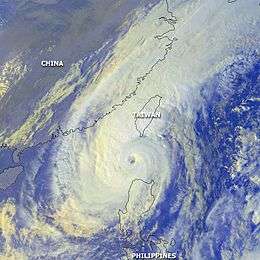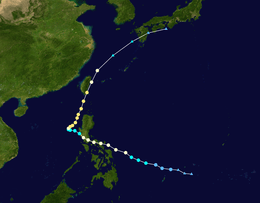Typhoon Xangsane (2000)
Typhoon Xangsane, known in the Philippines as Typhoon Reming, was a typhoon that hit Philippines and Taiwan in 2000. Xangsane hit southern Luzon of the Philippines. It turned to the north over the South China Sea, and after strengthening to a 100 mph typhoon it hit Taiwan. Xangsane dissipated on Nov. 1st, after causing 181 casualties, 83 of which were from the crash of Singapore Airlines Flight 006 the previous day on October 31, 2000.
| Typhoon (JMA scale) | |
|---|---|
| Category 2 typhoon (SSHWS) | |
 Typhoon Xangsane (31st October) | |
| Formed | October 24, 2000 |
| Dissipated | November 1, 2000 |
| Highest winds | 10-minute sustained: 140 km/h (85 mph) 1-minute sustained: 165 km/h (105 mph) |
| Lowest pressure | 960 hPa (mbar); 28.35 inHg |
| Fatalities | 181 total |
| Areas affected | Philippines, Taiwan |
| Part of the 2000 Pacific typhoon season | |
Meteorological history

On October 24, the formation of a tropical cyclone began in the waters near Palau, and on the 25th, the tropical cyclone number 30W was numbered by the Joint Typhoon Warning Center (JTWC). In addition, the tropical cyclone reached the surveillance area in the Philippines, so it was named Philippine name "Reming" by PAGASA. After that, 30W (Reming) was named "Xangsane". This is the name proposed by Laos and means "Elephant". Xangsane crossed Luzon, Philippines from 27th to 28th. After that, it proceeded to the South China Sea on 29th and strengthened the power to a 100 mph while changing its course to the north. Xangsane approached Taiwan from 31st to 1st November and changed to an Extratropical cyclone in the East China Sea at 12:00 (UTC) 1st November.[1][2]
Also, the 15th storm that approached Japan in 2000 was this Xangsane.[3] 2000 was a rare year when the number of storms approached Japan was relatively a lot, even though there were no storms that landed in Japan.
Impact
Xangsane hit the Manila metropolitan area. Heavy winds and heavy rains were happened in Quezon, Bulacan, Zambales and Pangasinan, as well as in the Bicol region of southern Luzon.[4] In Tayabas, Quezon, rainfall of 312.3 mm is observed per 24 hours.[4] The storm killed 40 people, lost 100,000 homes, and caused damage of $27.45 million.[5]
In Taiwan, floods killed 59 people and cost them $500 million.[5] On October 31, when Xangsane was approaching Taiwan, an accident of Singapore Airlines Flight 006 occurred at Zhongzheng International Airport (now Taiwan Taoyuan International Airport). Initially, it was suspected that the accident was due to the effect of Xangsane, but it was later discovered that the accident was due to a pilot error. However, some argue that this pilot error was due to poor visibility from Xangsane.[5]
External links
| Wikimedia Commons has media related to Typhoon Xangsane (2000). |
References
- Annual Report on Activities of the RSMC Tokyo - Typhoon Center 2000、P.42
- "台風200020号 (XANGSANE) - 詳細経路情報" (in Japanese). デジタル台風. Retrieved 2015-03-20.
- "気象庁|台風経路図2000年". www.data.jma.go.jp (in Japanese). Retrieved 2020-08-02.
- O., Jr., Lucrecio (2000). "Typhoon Reming 0014 (XANGSANE) :a Stride Team case study". NDRB. PAGASA: 41. Retrieved 2015-03-20.
- Annual Tropical Cyclone Reports、P.181
